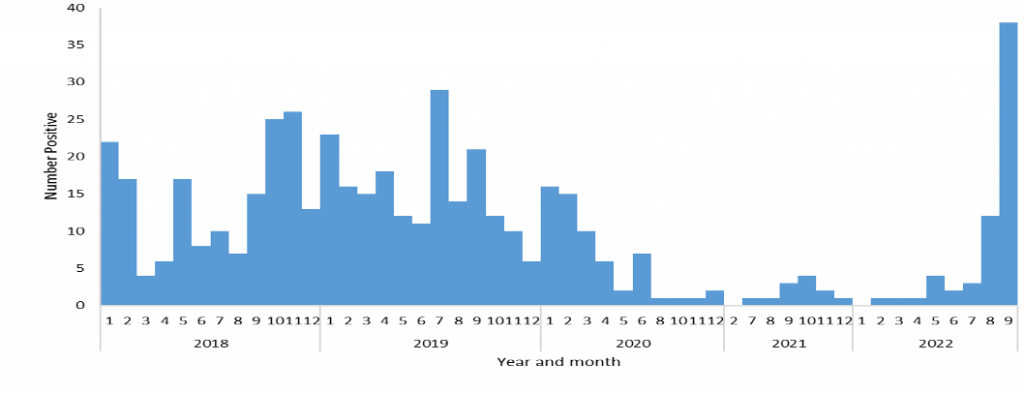Very few pertussis cases were reported through the notifiable medical conditions (NMC) surveillance system in 2020 (n=169) and 2021 (n=27) in South Africa, likely as a result of decreased transmission related to non-pharmaceutical interventions to prevent the spread of SARS-CoV-2. From the beginning of 2022 to 15 September, 147 pertussis cases were notified, with a steady increase in the number of cases reported since May and a sharp increase from July (n= 23 cases) through August (n = 33) and September (n = 53) (Figure1).

Of the 147 cases, 77% were children less than 5 years of age (113/147) of which 89 (79%) were children less than 3 months. The majority of cases 42%, (62/147) were from the Western Cape (Figure 2). In July and August 2022, the cases reported were evenly distributed across provinces and in keeping with numbers reported before COVID-19, while in September 2022, the majority of cases, 79% (38/48) were reported from Western Cape and numbers higher than those reported from this province pre-COVID-19 (Figure 2).

Figure 2: Number of notified pertussis cases in Western Cape from Notifiable Medical Conditions (NMC) line list, 2018-2022
Of the 38 cases reported from the Western Cape in September, 89% (34/38) of cases were observed from children less than 5 years of which 74% (25/34) were children less than 3 months. Of the 34 children less than 5 years of age, only 26 have vaccination statuses, of which 65% (17/26) were up to date with their vaccinations.
Pertussis, commonly known as ‘whooping cough’ is a vaccine-preventable disease caused by Bordetella pertussis and is a notifiable medical condition according to the National Health Act, 2003 (ACT NO. 61 0F 2003). Immunity following vaccination is thought to last for 5-6 years. Episodic increases in pertussis cases occur in vaccinated populations every 3-5 years.
Clinicians are advised to:
- Be on the alert for cases
- Conduct diagnostic testing where appropriate
- Report and notify cases
- Prescribe post-exposure prophylaxis to close and high-risk contacts of suspected or confirmed cases
Parents/guardians with children less than 5 years of age are encouraged to:
- Ensure that children are up to date with vaccination
- To seek medical help early especially for very young children where the illness may be severe
Pertussis symptoms may vary from person to person. Initial signs and symptoms are similar to the common cold and may include nasal congestion, runny nose, mild sore throat, mild dry cough and minimal or no fever. Days later, the cough can become more severe and is characterised by episodes of paroxysms (violent and uncontrolled coughing that is exhausting and painful) followed by a whooping sound and/or vomiting after coughing.
To read more on pertussis, click here: https://www.nicd.ac.za/diseases-a-z-index/pertussis/
References
- World Health Organization. Pertussis vaccines: WHO position paper, August 2015–Recommendations. Vaccine 2016; 34(12):1423-1425.
- Tiwari T, Murphy TV, Moran J. Recommended antimicrobial agents for the treatment and postexposure prophylaxis of pertussis: 2005 CDC Guidelines. Morbidity and Mortality Weekly Report: Recommendations and Reports. 2005 Dec 9;54(14):1-6.
- https://www.nicd.ac.za/wp-content/uploads/2017/03/Guidelines_pertussis_v1_20-December-2017_Final.pdf


